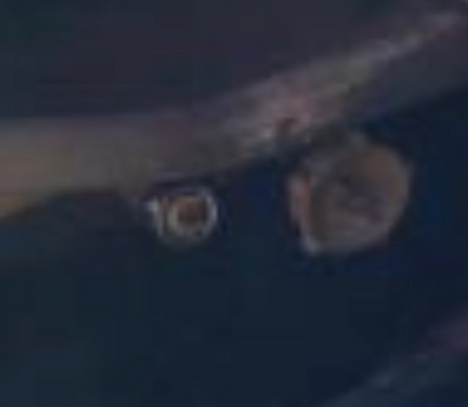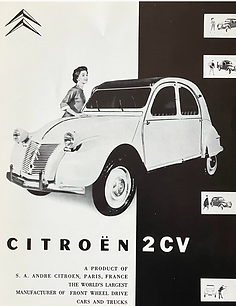
Seattle Citroën
US / Canadian 2CV's
NEW
8/2025
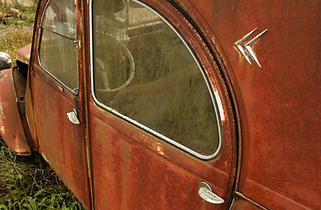
oldparkedcars.com
This website has been devoted to the topic of documenting changes that Citroën had to make to to their cars to import them into the USA and Canada. The topic of North American 2CV’s is something we have repeatedly put on the back burner, but we finally decided to take a look into it.
Note that we are only looking into 2CV's that were officially imported, not the any of the grey market importation efforts that took place in the 1980's.
But almost immediately, we discovered that there is very little consistency with what Citroën did with 2CV’s to import them. This is in contrast to DS’s and SM’s where the changes for US or Canadian models were almost completely consistent across the country.
There is near zero documentation of the changes on North American 2CV’s, which greatly hurts the ability to research and document the differences. We think that part of the problem is the incredibly small numbers of 2CV’s sold in North America. As a result, the following description of changes is largely based on vintage photos, surviving cars, brochures, newspaper archives, books, advertising, and memories. The parts books help a bit, but just a bit.
The following people helped prepare this article: Richard Bonfond, Tim Broers, Erik DeWidt, Chris Dubuque, George Dyke, Mark Krahn, Greg Long, and Kenji Yoshino.
WHY DID CITROEN TO MAKE CHANGES TO NORTH AMERICAN 2CV’s?
Governmental regulations drove many changes to 2CV’s imported to North America, but marketing decisions also caused changes.
The first highly organized attempt of the US government to regulate automobiles happened in 1966 when president Lyndon B. Johnson signed into law landmark legislation concerning motor vehicle safety. This act ultimately created the National Highway Traffic Safety Administration (NHSTA) and resulted in a set of design and test standards called, Federal Motor Vehicle Safety Standards (FMVSS). Most of the FMVSS’s became effective on January 01, 1968, although a few, such as FMVSS #209 for seat belts, kicked in a bit earlier.
Before the FMVSS’s were mandated, there was an uncoordinated patchwork of state laws and federal laws in place for automotive safety. Many of these laws specified design practices created earlier by the Society of Automotive Engineers (SAE), a non-governmental organization that was founded in the early 1900’s. It would have been this uncoordinated patchwork of state laws, federal laws, and industry design recommendations that Citroën would have had to navigate when trying to import 2CV’s.
Canada had their own requirements and laws. The most significant change to Canadian laws happened in 1971 when Canada adopted automotive safety rules similar (but not identical) to the US rules. Canadian rules were called, Canada Motor Vehicle Safety Standards (CMVSS), a name and acronym very similar to the US version. But since 2CV’s were imported into Canada well before the CMVSS’s were adopted, early Canadian rules were apparently a bit like the early US rules; sporadic across the various Provinces and not centralized into one agency.
The takeaway from this discussion about regulations is that in the era that 2CV’s were imported to North America, there was not a single set of automotive rules to adhere to, meaning that a 2CV sold in one State (or Province) might have different features than one sold in another.
This is a good time to repeat Richard Bonfond's famous quote:
“…the only thing that was consistent about Citroën in the USA was that nothing was consistent….”
WHEN WERE 2CV’s OFFICALLY IMPORTED TO NORTH AMERICA?
There is evidence that there were a few 2CV’s in the USA in the early 1950’s, but it was not until 1955 when 2CV’s were officially offered in the USA by Citroën's American subsidiary called, Citroën Cars Corporation. This slightly predates the arrival of the DS, since the first DS’s started arriving in US showrooms in the spring of 1956.
The following letter signifies the practical start of Citroën's presence on the west coast of the USA. This letter, dated February 10, 1955, informs the owner of Challenger Motors that Citroën was now starting sales operations on the west coast. The east coast had similar timing.
THIS LETTER SIGNIFIES THE OFFICIAL START OF CITROEN'S OPERATIONS ON THE WEST COAST
(CLICK TO OPEN)
Toni Werk
February of 1955 marked the beginning of Citroën's USA operations, but when were new 2CV's actually on dealership lots? It seems that this happened a bit later in 1955. Below is one of the first advertisements from a third-party dealership that we can find for officially-imported 2CV’s, dating from November of 1955 (oddly, from a dealer in Alaska). Other dealers around the USA followed with their own advertising, starting in early 1956.
FIRST ADVERTISEMENT WE CAN FIND FOR AN OFFICALLY-IMPORTED 2CV

Fairbanks Daily News, Nov 1955
Citroën offered AMI 6 models in the USA in the early 1960’s, but sales were even more abysmal than that of the 2CV. In 1969 and 1970, the Mehari was sold in the USA with limited success.
EARLY BROCHURE FOR 2CV's IN THE USA (CLICK TO OPEN)
In Canada, the first officially imported 2CV’s arrived in the spring of 1958. However, the first importers in Canada were not Citroën themselves – instead, the first importers were independent Canadian businesses that Citroën had recruited. The first and most consequential of these independent importers was a man named Harry Dubrofsky, a Montreal-based businessman. In early 1958, Dubrofsky met with a Citroën export manager named Alain Feraut who had been dispatched from Paris to find Canadian businessmen who would take on this independent importer role. Dubrofsky signed-up and named his business Auto-France. By May of 1958, Dubrofsky had new Citroëns on his car lot in Montreal.
Harry Dubrofsky was assigned to be the Citroën importer for the Province of Quebec. Within a few months, the husband/wife team of Jim and Alice Fergusson were assigned Ontario, and a company called Double-Nine Motors was assigned to be the Citroën importer for the west; British Columbia, Alberta, Saskatchewan, and Manitoba.
AUTO-FRANCE ADVERTISEMENT

Once the cars that these independent importers purchased had left France, it is said that Citroën washed their hands of them. Marketing, training, facilities, warranty issues, and spare parts were entirely left up to the independent importers to deal with.
As you can imagine, this independent importer strategy was not successful and only lasted for a few years. In 1962, Citroën came into Canada themselves and formed a company called, Citroën Canada Ltée. When Citroën arrived, they scrapped the independent importer strategy, thus driving Auto-France and the other independent importers out of business. You can read more about the independent importers in Canada HERE.
Once Citroen Canada took control in 1962, they advertised 2CV’s, but enthusiasm to spend advertising dollars on the 2CV dried up quickly. There were very few Canadian 2CV advertisements after 1963.
Citroën Canada also offered Ami6’s and Dyanes in the 1960’s, but these models were even less popular than 2CV’s. A few Meharis were imported into Canada as well.
WHEN DID CITROEN STOP IMPORTING 2CV’s TO NORTH AMERICA?
In the USA, 2CV’s dropped out of the pricelists in about 1965. However, Richard Bonfond indicates that with a bit of arm-twisting, a customer could still special order a 2CV through the US dealership network (often under Citroën’s European Delivery program) until 1967. But as of January 1, 1968, a plethora of new Federal safety and emission rules kicked-in, bringing a hard-stop to any official importation of 2CV’s.
In Canada, 2CV’s were in the pricelists until about 1969 or 1970. Canada imposed their new safety and emission rules in 1971, bringing an abrupt end to any official importation of 2CV’s into Canada.

CANADIAN PRICELIST FROM 1969
HOW MANY 2CV’s DID CITROEN SELL IN NORTH AMERICA
There does not seem to be any trustworthy counts of the number of 2CV’s officially sold in the US or Canada, but it is safe to say that the numbers were incredibly small. It has been reported that after Citroën left North America all of the records, in both USA and Canada, were thrown away.
The Hagerty Insurance company reports that over the decade that 2CV’s were officially sold in the USA, a total of about 1000 cars were sold, so this means an average of something like 100 cars-per-year, which seems a reasonable estimate to the reviewers of this article.
For Canada, the January 22, 1965 Toronto Daily Star newspaper reports that there were only 100 2CV’s in all of Canada at the time, and only 10 of those were in Toronto. Several of us have been trying to estimate the total number 2CV’s officially imported into Canada and the estimates are hovering in the 300-400 range.
FRENCH VS BELGIAN 2CV’s
Most of the very first officially-imported 2CV’s to the USA were Belgian-built cars, as evidenced by unique features such as the unusual trunk lid, fender-mounted trim, formed aluminum bumpers, unique steering wheels, etc. The importation of Belgian 2CV’s didn’t last long however and French-built cars soon took over. Based on period photos and surviving cars, it seems that most of the Belgian cars were 1956's and by 1957 or so, most (or all) were French-built.
An example of a Belgian 2CV is this derelict 1956 Arizona car that is thought to have been originally delivered through Citroën’s Los Angeles facility. It is profiled on the Citroenvie website HERE.

Citroenvie
1956 BELGIAN 2CV PROCESSED THROUGH LOS ANGELES
CHANGES MADE TO NORTH AMERICAN 2CV’s
HEADLIGHTS
In 1940, a consortium of state regulators came together and mandated the use of two 7 inch sealed-beam headlights on all cars sold in the USA. This requirement remained in place until 1957, when four 5 3/4 inch sealed-beam headlights were also allowed. Later on in the mid-1970’s, the federal government allowed rectangular sealed beams to be added to the list of allowable headlights. Sealed-beam headlights are one of the very few regulations of the era that existed federally, applying to all 50 states. This means that all 2CV’s imported to the USA were required to have been retrofitted with sealed beams (there is an "oops" coming later).
Initially, 2CV’s arrived in the USA without any headlight buckets at all, as can be seen in this fantastic early photo of the Los Angeles Citroën facility at 8423 Wilshire Boulevard. After the first few years, cars started arriving from France with the Euro headlights still installed, meaning that Citroën USA employees would need to remove them in order to install the American sealed beam headlights and buckets.
.jpg)
Bonfond family archives
NEW 2CV's ARRIVING IN LOS ANGELES
For replacement headlights, Citroën sourced off-the-shelf headlight buckets in the USA that were equipped with standard 7-inch sealed beam lamps. The sealed beams were a bit larger than the Euro headlights, giving the car even more of a cartoon-like appearance. The sealed beam headlight buckets were supposedly installed before the cars were sold to a customer, but as we shall see, mistakes were made....
There appear to have been two or three different headlight buckets used by Citroën USA since some had subtle shape differences and some had chrome plating. Two manufacturers used were R.E. Dietz and King Bee, but there may have been others as well.
Below are several photos of USA headlights on early American 2CV’s.

Bringatrailer.com

Tim Broers
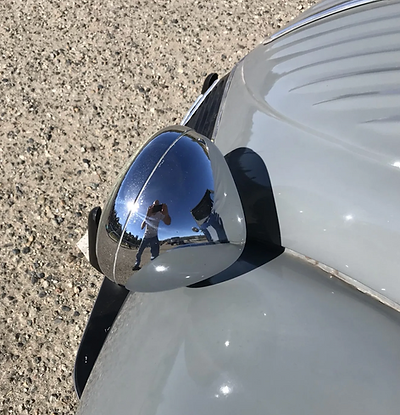
Bringatrailer.com
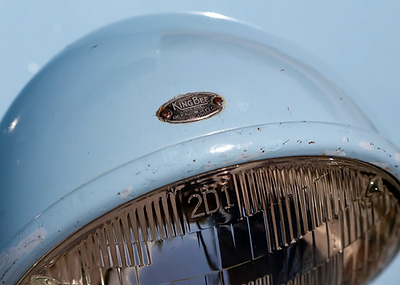
Bringatrailer.com

Mark Krahn
But it is also possible to find 2CV’s that were sold in the USA with the original Euro headlights. We know of quite a few examples, but one is the ex-Greg Long 1965 AZAM that has a very well documented provenance. This car was sold new by Citroën’s headquarters in Los Angeles and was immediately put in the Harrah car collection.

Greg Long
US-MODEL 2CV THAT SOMEHOW RETAINED ITS EURO HEADLIGHTS
We found two more white 2CV AZAM’s that are near identical to the Harrah car. These two cars (both 1964’s) also originally came from Citroën Los Angeles….and both also have Euro headlights, just like the Harrah car. One of these cars emerged from long-term storage in California and was sold at an auction in 2023. The second one is the car that was originally owned by the actor Sebastion Cabot. This Sebastion Cabot car passed through several hands and is now painted red and is in George Dyke’s collection.

BidCars
1964 CALIFORNIA AUCTION CAR

Greg Long
1964 SEBASTION CABOT CAR
How was it possible that 2CV’s were delivered to American customers with Euro headlights, despite this being illegal? Well, I am not sure, but it looks like someone at Citroën Cars Corporation simply didn’t do their job – whether purposely or inadvertently, we don’t know.
While Citroën USA was legally responsible for installing these types of parts, we have discovered that installation of USA-unique parts was sometimes delegated to the downstream dealers, which may explain some of the variability.
In Canada the story is even stranger. Although not required in Canada, a few Canadian 2CV's were equipped with 7-inch sealed beams while most retained their original lights. We have no idea why some had sealed beams, but one theory is that a few 2CV's sold in Canada had entered North America through the USA (and thus got the USA modifications) instead of being shipped directly into Canada. Does anyone out there have any other ideas?
TURN SIGNALS AND THE SIDEWAYS CHEVRONS
The turn signals are perhaps the most inconsistent feature on American 2CV’s.
It seems that it was primarily 2CV’s processed though the Los Angeles Citroën facility that were routinely equipped with Americanized turn signal lamps. 2CV’s sold in other states often retained their original European turn signal lamps that were mounted high on the side of the body. Some cars even had both.
Richard Bonfond tells the story of the Californian turn signals in his book, What a Ride – Growing up with Citroën in North America. He indicates that the two original turn signal lamps (that were mounted high on the side of the body) did not meet California's regulations and so they were removed. Instead, four individual lamps were installed, one at each corner of the car.
But what to do with the holes in the body where the original Euro turn signals were mounted? Well, Bonfond reports that someone at Citroën in Los Angeles noticed that the hole spacing matched that of Citroën’s double-chevron emblems, but only if the emblem was installed sideways. As a result, all that was necessary was to drill two additional holes and then chevron emblems were installed….sideways!
The sideways chevron trick ONLY happened on cars processed through Los Angeles, which was Citroën's west coast headquarters. Cars sold in other states did not get this same treatment. Based on photos and surviving cars, it seems that the sideways chevron solution did not occur on the very first cars, and instead showed up just a bit later, perhaps in the middle of 1956.
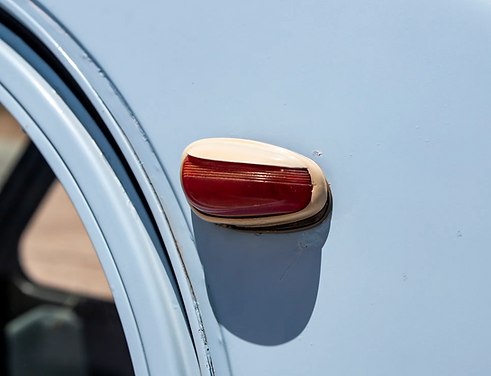
Bringatrailer
TYPICAL EARLY EURO TURN SIGNAL LAMP

Tim Broers
SIDEWAYS CHEVRONS ON A 1962 CAR FROM L.A.
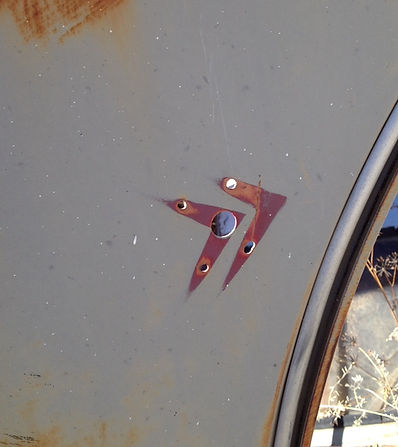
Greg Long
REPURPOSED HOLES IN THE BODY

Erik DeWidt
SIDEWAYS CHEVRONS ON A 1959 AZU
TURN SIGNAL LAMPS
Based on old photos and surviving cars, several different versions of turn signal lamps were installed by Citroën Los Angeles, suggesting that they tended to install whatever was handy on that particular day. The following photos show several of the different turn signal lamps found on west coast 2CV's. The most common lamps are shown first, followed by the less common ones.

Greg Long
TEARDROP LAMPS ON THE 1965 HARRAH 2CV AND MANY OTHER USA 2CV's IN THE MID-1960's

Greg Long


Chris Dubuque
SMALL LUCAS LAMPS ON TIM BROERS 1962 2CV
Chris Dubuque

oldparkedcars.com
LARGE LUCAS LAMPS ON A 1965

Wouter Bregman
UNUSUAL NARROW TURN SIGNALS ON THIS 1956 AZU
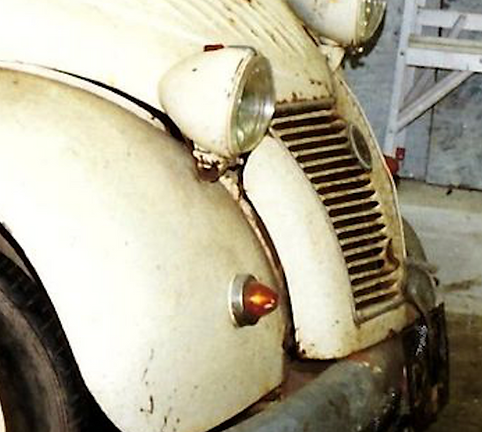
Erik DeWidt

Erik DeWidt
"YANKEE 975" LAMPS ARE INSTALLED ON ERIK DEWIDT'S (LOS ANGELES) 1960 AZU
A variation of the teardrop turn signals that Citroën Los Angeles installed can be seen on George Dyke’s famous 1958 art car 2CV (the ex-Bill Stevenson car, nicknamed Whimsy). It has four fender-mounted turn signals that look a bit similar to those on the Los Angeles cars, but the lamps are installed in different locations on the fenders. Furthermore, this car retained the Euro side-of-body turn signals. It is not known what state Whimsy was originally sold from, bit it is thought to be from the east coast.



George Dyke
TEARDROP TURN SIGNALS ADDED TO THE FENDERS, BUT THE ORGINAL TURN SIGNALS ARE STILL INSTALLED
2CV’s sold in other states often retained their original French turn signals with no additional lamps installed. We found many examples, but a good one is this very original grey 1960 2CV that was sold new by French Motor Cars in Eugene, Oregon. This car has some of the Americanized features (e.g. sealed beam headlights and a speedometer in miles-per-hour), but it retains the Euro turn signal arrangement.
Being a west coast car, the importation paperwork would have been processed through Citroën's Los Angeles headquarters. But many of the cars that Citroën imported were shipped directly from France to other ports along the west coast, meaning that this car was probably never physically in L.A. As such, it did not receive the exact modifications that the L.A. facility would have performed. Instead, the car would have been updated with the required parts locally, probably in Portland in this case, since Portland was the closest major port to Eugene. (Recognize also that Oregon's automotive laws were not the same as California's.)
We have been told that sometimes Citroën personnel would travel up and down the coasts and modify the cars before they were officially handed off to the third-party dealers (so-called, port-installed parts). Alternatively, sometimes the responsibility for the modifications was handed off to the third-party dealers to perform, which added to configuration consistency issues.

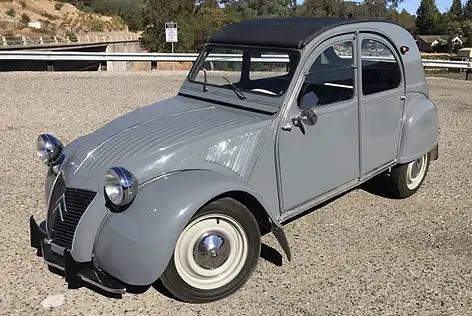
bringatrailer.com
1960 OREGON 2CV WITH ORIGINAL EURO TURN SIGNALS
For a while we wondered if the different turn signal arrangements were associated with the model year of the car. But no, there is no apparent pattern based on the year. The best explanation we can muster for the fact that 2CV’s sold across the USA had inconsistent configurations was that Citroën Cars Corporation was not demanding consistency with their USA homologation of 2CV’s. Combine this with the fact that some states had different rules than others, and you end up with a smorgasbord of configurations.
It seems that all Canadian 2CV’s retained their Euro turn signal lamps.
SPEEDOMETERS
All 2CV’s officially sold in the USA were supposedly equipped with speedometers calibrated in miles-per-hour. Surprisingly, it doesn’t look like this was federal requirement at the time - instead, I believe that this may have been a requirement that was adopted by most (or all) of the individual states. Whatever the case, Citroën developed speedometers in MPH, listed them in the parts books, and at least tried to install them in all USA 2CV's.
Even the very early cars with the small speedometer in the lower left corner of the windshield were calibrated in miles for the American market.
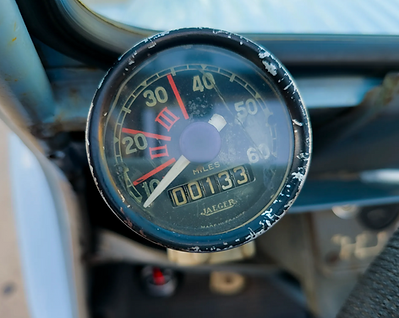
bringatrailer.com
1958 2CV SPEEDOMETER IN MILES

Greg Long
1965 2CV SPEEDOMETER IN MILES
What about Canada? Surviving examples suggest that Canadian 2CV’s were also calibrated in miles-per-hour. Parts book #644 shows several speedometer part numbers, calibrated in miles, specifically identified as applicable for Canadian 2CV’s. Note that Canada used ‘miles’ until 1977 when the country switched to ‘kilometers’.
There are exceptions of course, where 2CV’s in North America are found with speedometers in km. One way this can occur is if the car was brought into North America through Citroën’s European Delivery Plan. These cars often missed a few of the changes that cars sold in the USA received, with the speedometer being high on the list. But others might be just out of inconsistency.
CITROEN BADGES
Most early 2CV’s sold in the USA had a domestically-sourced Citroën badge installed, usually on the front left fender, but occasionally there was one installed on the trunk lid. These same badges were used on early DS’s imported to the USA.
While the badges may have missed the first few cars, we think by mid-1956, these badges were routinely installed on all west coast cars that were processed through Los Angeles. There are fewer east coast survivors, so it is more difficult to know when the badges were used by Citroën New York. Note however that DS's were routinely equipped with these badges on both east coast and west coast cars right from the start. The badges on 2CV's started to disappear by the early 1960’s, at about the same time they started disappearing on DS models. By 1962 or 1963, their systematic use had ended.
The badges were installed by Citroën USA employees, or in some cases, by the dealers themselves. Since a variety of people were installing them, their specific on the car location varied. There were also several different design badges. You can see some of them HERE.
Canadian 2CV's did not receive these badges.
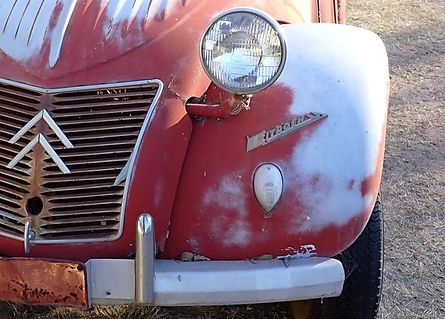
Citroenvie

bringatrailer.com
BADGES INSTALLED ON A 1956 AND 1958 2CV
“AC” DATA PLATE
Starting in 1960, west coast Citroëns in the USA (all models) had a small data plate installed under the hood that showed the model year of the car. An example would be “AC62” which is for a model year 1962 car. Some local licensing agencies added the AC number to the car’s serial number, sometimes not.
These tags are a bit mysterious and were not installed on every Citroën sold in the USA. While nobody is 100% certain of the whole story, Richard Bonfond and the late Carter Willey helped us understand it, at least as well as possible. The story was that Citroën had two main headquarters to import cars; Los Angeles and New York. The Los Angeles office handled all cars shipped to the west coast ports of the USA (west of the Rockies, such as LA, San Francisco, Seattle, etc.) and the New York office handled all cars that arrived at the various ports east of the Rockies. All west coast cars from 1960 had the AC tag. So far, I have not been able to find out the reason why west coast cars had the tag and east coast cars did not. The most logical guess is that the state of California required it, so they were installed on all cars processed by the Los Angeles office. The AC tags were installed by Citroën personnel as a port-installed part, like the sealed-beam headlights and other parts.
The data plate was rectangular on the first few years. By 1964, a flag-shaped data plate was used. These are the exact same parts that were used on west coast AMI's, DS's, Meharis, and SM's.
Canadian 2CV's did not receive these plates.
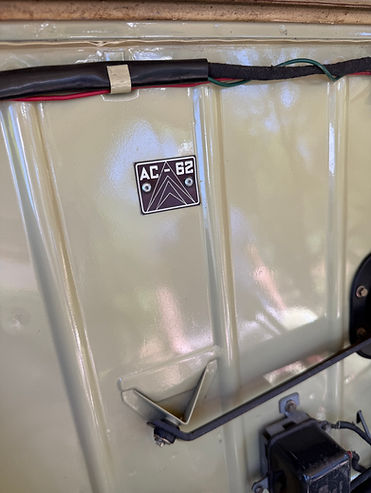

Greg Long
FLAG-SHAPED DATA PLATE USED ON A 1965 2CV
Chris Dubuque
SQUARE AC DATA PLATE USED ON TIM BROERS 1962 2CV
THE CANADIAN SPECIFICATION 2CV
By the mid-1960’s, Citroën finally reacted to customer complaints that their cars were not well suited to the harsh Canadian climate. For DS’s, they decided to come up with a special configuration, just for the Canadian market. These Canadian Specification DS’s debuted in 1965 and had several unique features, including to make the -15C Cold Weather Option and the Dust Option standard equipment for Canada. The main feature of the -15C option for the DS was the addition of a secondary heater to cope with the cold weather. The dust option on the DS consisted of special filters for the hydraulic reservoir, the gearbox breather, and the gas tank breather.
At about the same time that Citroën developed the Canadian Specification DS in 1965, 2CV’s also received a special version for Canada. These Canadian Specification 2CV’s included the following features:
-
The -15C option (which consisted of a gas-fueled heater)
-
A change from a 6-volt electrical system to a 12-volt system
-
The addition of the Pays d'Outre-mer (overseas countries) option which included special features to protect against dust and unimproved road conditions
Each of these items will be discussed separately:
AUXILARY HEATER
One of the features of Canadian Specification 2CV’s was the adoption of a cold weather option that became standard equipment for Canadian 2CV’s in 1965. This feature was called the -15C option and the prominent feature was the addition of a gas-fueled heater made by Gurtner, a French company that is well known for making carburetors for small displacement moped engines. A Double Chevron Magazine from 1965 introduced the gas heater as a new development for the 2CV and indicated that it would be made available for cold weather markets.
Citroën dealers in Canada immediately started advertising that Canadian 2CV’s were equipped with the gas heater, such as in the following advertisement from an Ontario dealership.

Kingston Whig, May 1965
GAS HEATER STANDARD IN CANADA AS OF 1965
The heater itself was installed laterally in the engine compartment, above the gearbox. An oval air intake vent was cut in the front right fender, complete with a bug screen. A large flexible hose connected the air inlet on the fender to the heat exchanger. A 12-volt electric fan to the blow warm air into the cabin was mounted inside the sheet metal heater box.
Parts book #644 includes the -15C option and lists all of the gas heater components, including the Gurtner unit itself, ducts, hoses, wiring, and associated hardware. The fact that the Gurtner heater is included in the parts book indicates that the gas heater was likely installed at the factory (as opposed to being installed after the cars were in Canada).

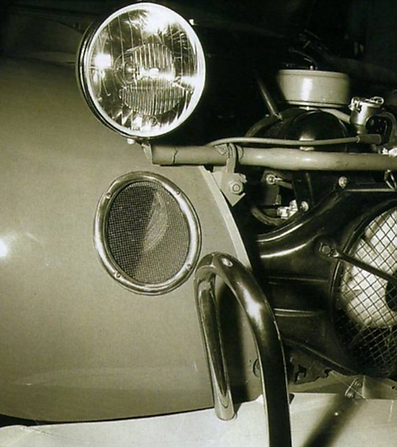
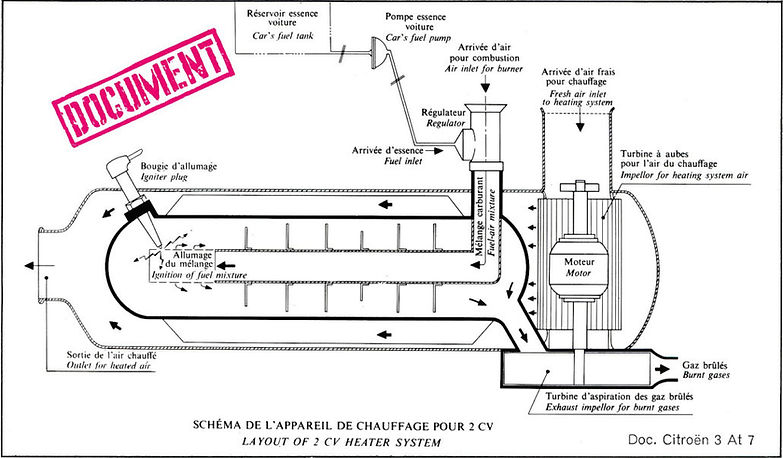
Double Chevron
Fortunately, several examples of Canadian 2CV’s with the gas heater still exist, including a red 1967 and a green 1969 that were both purchased new in Toronto. You can read more about these two cars HERE.

Citroenvie

Greg Long

Citroenvie

Citroenvie
SEVERAL CANADIAN 2CV's WITH THE GAS HEATER
12 VOLT ELECTRICAL SYSTEMS
Twelve-volt electrical systems are considered to have better performance in cold weather than 6-volt systems and accordingly, Citroën decided to include a 12-volt electrical system as part of the -15C option. As such, all Canadian 2CV’s from 1965-on received 12-volt systems, while 2CV’s heading to most other countries remained 6-volt for several more years.
For the 12-volt system, a special belt-driven generator was employed, causing quite a few differences on the engine, including almost all of the sheet metal cooling shrouds, the manifolds, etc. Also, the headlight bar was different and included a bump-out to allow room for the new generator. These unique parts are identified in parts book #644.
You can see the generator in the following photo of a derelict Canadian 2CV from Montreal. This photo also shows the special headlight bar with the bump-out.


CANADIAN SPECIFICATION 2CV WITH THE GURTNER HEATER AND 12 VOLT ELECTRICAL SYSTEM
The change to 12-volt cascaded to other electrical components such as the voltage regulator, starter, wiper motor, bulbs, etc.
2CV’s that went to certain other cold weather countries (such as in Scandinavia) also got the -15C option, which meant that they also received the Gurtner heater and early adoption of the 12-volt electrical system.
AIR CLEANER
As part of the Canadian Specification 2CV that was developed in 1965, Citroën included an option that had features for harsh environments, formally called the Pays d'Outre-mer (overseas countries) option. The 2CV parts books refer to this option with the acronym P.O.
As part of the P.O. option, special dust-tolerant air cleaners were developed. The most common air cleaner for the P.O option was a very large oil-bath type mounted on the right side of the engine bay. However, it could not be used when the -15C option and the P.O. option were used simultaneously, due to space constraints. As a result, Canadian cars received a special dust-tolerant air cleaner that worked when both options were installed. Below are photos of the standard 2CV air cleaner, the large oil-bath air cleaner, and the special air cleaner used on Canadian 2CV's from 1965.

artcurial.com
STANDARD 2CV AIR CLEANER OF THE ERA

Tim Broers
OIL-BATH AIR FILTER FOR MOST P.O. CARS

Citroenvie
SPECIAL DUST TOLERANT AIR CLEANER USED ON CANADIAN 2CV's FROM 1965
PROTECTIVE SHIELD
As part of the Pays d'Outre-mer (P.O.) option, a sturdy sheet metal pan was installed on the frame under the engine and transmission. Since Canadian 2CV's all received the P.O. option as of 1965, they were all equipped with this plate.
The special bolt-on plate covered the entire rectangular opening in the frame where the drivetrain is located, but had a few holes to access the drain plug(s). This pan had dual function; since it was made out of thick sheet metal, it acted as a skid plate to protect the engine case. Also, being a full pan, it helped prevent dust, dirt, and water from entering the engine compartment.
According to the parts book, this metal shield was used on other 2CV models in certain years, but it was on ALL cars with the P.O. option and therefore on all Canadian 2CV’s as of 1965.

Erik DeWiidt

SODO Moto
FULL COVERAGE 2CV UNDERPAN USED WITH THE P.O. OPTION
TIRES
As part of the Pays d'Outre-mer (P.O.) option, Citroën increased the tire size from 125 to 135 mm width. Since all Canadian 2CV’s received the P.O. option in 1965, we think that 135R15 Michelin X tires would have been used on all Canadian 2CV’s as of 1965.

WIRING
As part of the Pays d'Outre-mer (P.O.) option, specially-wrapped wiring harnesses were used. This extra wrapping was intended to improve chafe protection and perhaps reduce moisture ingression. This special cloth tape is distinctive since it has a light-colored thread woven into the tape.

2CVCO.canalblog.com

forum.2CV-legende
SPECIAL TAPE WRAP ON THE WIRING HARNESSES OF P.O. 2CV’S
Canadian cars therefore had this wiring, starting in 1965. These special wiring harnesses are listed in the parts book(s).
FRONT BUMPER
As part of the Pays d'Outre-mer (P.O.) option, Citroën included a tubular front bumper that had a small skid plate on the bottom. All Canadian specification 2CV’s (1965 onward) had the P.O option and therefore were equipped this bumper.

Citroenvie
TUBULAR FRONT BUMPER WAS USED ON CANADIAN SPEC. 2CV’s FROM 1965
CHASSIS REINFORCEMENTS
As part of the Pays d'Outre-mer (P.O.) option, Canadian 2CV’s from 1965 contained a number of less visible changes on the chassis, such as various strengthened areas, better grease seals in the suspension, and more substantial suspension bump stops. Some sources indicate that the chassis on P.O.-equipped sedans was actually an AZU (truckette) chassis and not a sedan chassis. Perhaps someone reading this can confirm if this is true?
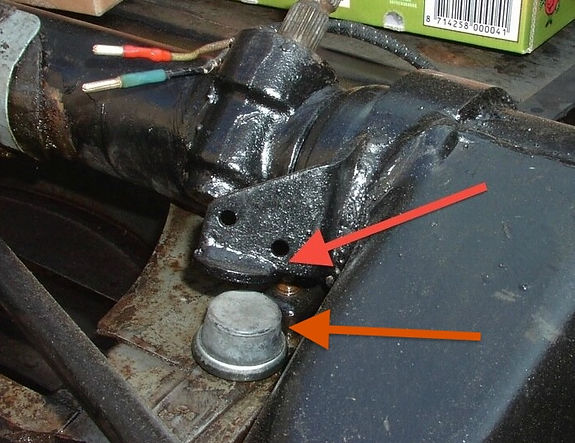
2CVCO.canalblog.com
LARGE RUBBER BUMP STOPS INCLUDED WITH THE P.O. OPTION
GLASS
Despite quite a bit of research, it is unclear to me when windshields made with laminated safety glass were first required in the USA, although their use in America started in the late 1930’s and by the 1960’s most cars sold here had them. As a reference point, all DS’s sold in the USA were equipped with laminated safety glass windshields and tempered safety glass on the remaining windows.
The parts books indicate that all 2CV’s of the era (both Euro and North American) were equipped with a special type of tempered glass windshield called a VISURIT windshield. VISURIT windshields were standard tempered glass, but a small circle in the driver’s field of view went through a different tempering process, to aid in visibility if the rest of the windshield was to shatter. If you look at a VISURIT windshield at certain angles, you can faintly see the circle of un-tempered glass in front of the driver. Below is a photo of a shattered VISURIT windshield on an early VW Beetle that has this design, showing how the driver is still able to see through the specially prepared area.
Tim Broer's very original 1962 US-model 2CV still has its original VISURIT windshield.
There is an exception in the parts book for German 2CV's which seem to have a thicker 5 mm windshield part number specified. It is presumed that the standard thickness was 4 mm.

THIS IS WHAT A “VISURIT” STYLE OF WINDSHIELD LOOKS LIKE WHEN SHATTERED
The remaining glass (side windows are rear windows) were all standard tempered glass.
Based on all of this, it appears that 2CV’s in the USA did not have unique glass and did not have laminated safety glass windshields.
We did find one source that indicated that 2CV’s equipped with the Pays d'Outre-mer (overseas countries) P.O. option may have had laminated safety glass windshields. If true, this would have affected Canadian 2CV’s from 1965, but we have not been able to confirm this and there is no evidence for such in the parts book.
STARTER AND CHOKE CABLES
Parts book #446 shows that Canadian cars had special starter and choke cables for 1963-on that were labelled in English:
STARTER CABLE: Labelled “S” for starter instead of “D” for Demarreur
CHOKE CABLE: Labelled “C” for choke instead of “S” for Starter (which is ‘choke’ in French)
USA cars are not specified as getting these English language cables in the parts book(s). But we found that after about 1963, many (but not all) North American 2CV's did end up with the English-labeled cables. This is yet another inconsistent configuration for North American 2CV's.

1964 USA 2CV WITH A CHOKE KNOB LABELLED WITH A "C"
